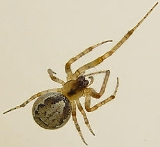
Zygiella x-notata
Encyclopedia

Description
Z. x-notata females are up to 11mm in size, males up to 7mm. The prosoma is yellow-brown, with a leaf-like mark on the opisthosomaOpisthosoma
The opisthosoma is the posterior part of the body in some arthropods, behind the prosoma . It is a distinctive feature of the subphylum Chelicerata...
. In moderate climate, adults appear from July to October, sometimes even into December. In warmer regions, they are active all year.
This spider builds its web mostly into window frames, but can also be found on walls, fences, or under the bark of old trees. It is very common around boats and docks throughout the world. Z. x-notata is a warmth-loving animal.
Web
Adult spiders build an orb-webSpider web
A spider web, spiderweb, spider's web or cobweb is a device built by a spider out of proteinaceous spider silk extruded from its spinnerets....
with two sectors without connecting threads in one of the two upper corners. The signalling thread in the middle of these sectors leads to the spider's hideout. In the evening and at night, however, the spider sits in the center of the web. It renews the web in the morning hours.
A normal web consists of about 25 to 30 radial threads. Young spiders, and sometimes adults, build webs without the free sectors, especially if the angle between signalling thread and radii gets too big.

